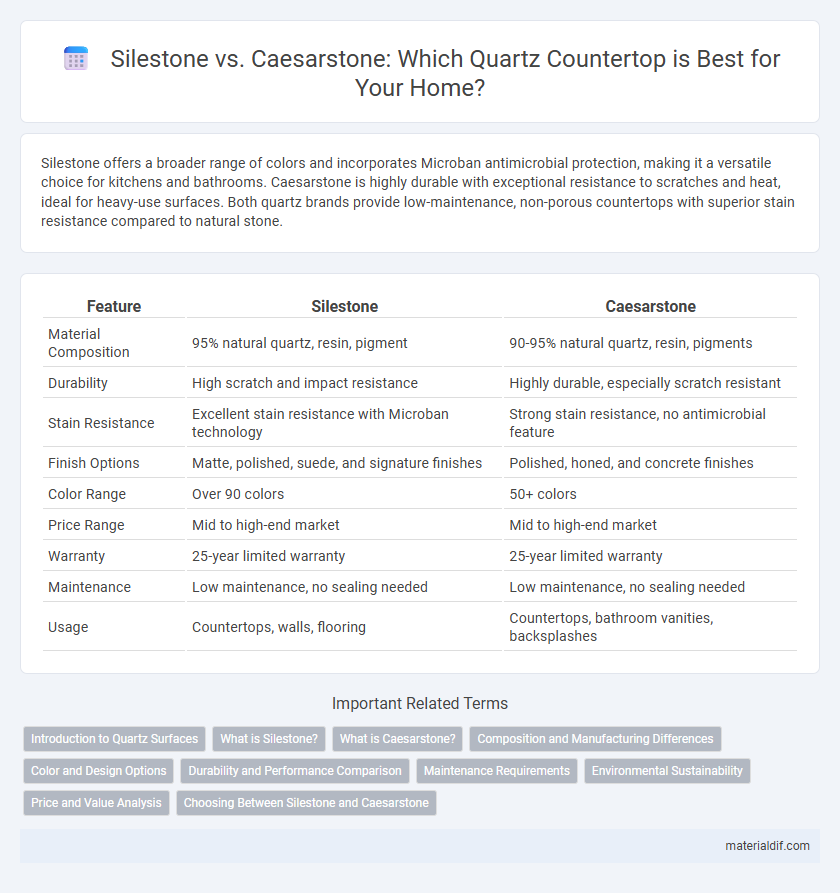Silestone offers a broader range of colors and incorporates Microban antimicrobial protection, making it a versatile choice for kitchens and bathrooms. Caesarstone is highly durable with exceptional resistance to scratches and heat, ideal for heavy-use surfaces. Both quartz brands provide low-maintenance, non-porous countertops with superior stain resistance compared to natural stone.
Table of Comparison
| Feature | Silestone | Caesarstone |
|---|---|---|
| Material Composition | 95% natural quartz, resin, pigment | 90-95% natural quartz, resin, pigments |
| Durability | High scratch and impact resistance | Highly durable, especially scratch resistant |
| Stain Resistance | Excellent stain resistance with Microban technology | Strong stain resistance, no antimicrobial feature |
| Finish Options | Matte, polished, suede, and signature finishes | Polished, honed, and concrete finishes |
| Color Range | Over 90 colors | 50+ colors |
| Price Range | Mid to high-end market | Mid to high-end market |
| Warranty | 25-year limited warranty | 25-year limited warranty |
| Maintenance | Low maintenance, no sealing needed | Low maintenance, no sealing needed |
| Usage | Countertops, walls, flooring | Countertops, bathroom vanities, backsplashes |
Introduction to Quartz Surfaces
Quartz surfaces, such as Silestone and Caesarstone, are engineered stone products composed of approximately 90% natural quartz combined with resins and pigments. Silestone is known for its high resistance to stains and scratches, offering a wide variety of colors and integrated antibacterial protection. Caesarstone stands out for its durability, low maintenance, and innovative surface textures, making both brands popular choices in kitchen and bathroom countertops.
What is Silestone?
Silestone is a high-quality quartz surface composed of over 90% natural quartz, renowned for its durability, resistance to stains, and non-porous properties that make it ideal for kitchen countertops and bathroom surfaces. Manufactured by Cosentino, Silestone incorporates a proprietary bacteriostatic protection that inhibits the growth of bacteria and mold, enhancing its hygiene standards. Its wide range of colors and finishes offers versatility for both residential and commercial interior design projects.
What is Caesarstone?
Caesarstone is a premium quartz surface brand known for its durability, non-porous composition, and resistance to stains and scratches, making it ideal for kitchen countertops and bathroom vanities. Manufactured using approximately 93% natural quartz blended with resin and pigments, Caesarstone offers a wide range of colors and finishes that combine aesthetics with high performance. This engineered stone material requires minimal maintenance while providing superior hardness compared to many natural stones.
Composition and Manufacturing Differences
Silestone is composed primarily of 94% natural quartz combined with a blend of resins and pigments, utilizing a proprietary HybriQ+ technology for enhanced stain and scratch resistance. Caesarstone consists of approximately 93% quartz mixed with polymer resins and colorants, manufactured through a vibration and compaction process followed by baking for durability. The key difference lies in Silestone's patented antimicrobial protection and enhanced resin formula, while Caesarstone emphasizes a more traditional manufacturing method with consistent density and flexibility.
Color and Design Options
Silestone offers a wider palette of over 100 vibrant colors and unique textures, incorporating natural quartz and antimicrobial properties for durability and hygiene in kitchen surfaces. Caesarstone also provides a broad range of colors and designs, including sleek, modern patterns and classic stone looks, with a focus on consistent quality and subtle, elegant finishes. Both brands excel in customization, but Silestone stands out for its bold and innovative color options, while Caesarstone is favored for timeless, sophisticated aesthetics.
Durability and Performance Comparison
Silestone and Caesarstone quartz surfaces both exhibit high durability with resistance to scratches, stains, and heat, making them ideal for kitchen countertops and bathrooms. Silestone incorporates a proprietary antimicrobial protection called Microban technology, enhancing its performance by inhibiting the growth of bacteria and mold on the surface. Caesarstone quartz offers slightly higher hardness on the Mohs scale, contributing to its superior scratch resistance and long-term structural integrity.
Maintenance Requirements
Silestone requires regular cleaning with mild soap and water to maintain its stain resistance and avoid using harsh chemicals that can damage the surface. Caesarstone is similarly low-maintenance but benefits from immediate cleanup of spills to prevent potential staining and uses non-abrasive cleaners for durability. Both quartz brands offer excellent durability with comparable maintenance routines, though Silestone's Microban technology provides enhanced antimicrobial protection.
Environmental Sustainability
Silestone and Caesarstone both emphasize environmental sustainability through their use of recycled materials and low-emission manufacturing processes. Silestone utilizes Eco-Friendly technology that reduces waste and carbon footprint, earning certifications like GREENGUARD and NSF. Caesarstone incorporates up to 40% recycled content in some collections and complies with stringent environmental regulations such as LEED and NSF 51, promoting sustainable quartz surface options.
Price and Value Analysis
Silestone quartz surfaces typically range from $50 to $100 per square foot, offering a balance of durability and premium features like antimicrobial protection. Caesarstone quartz slabs average between $55 and $120 per square foot, often priced higher due to trend-driven colors and slightly enhanced hardness. Value analysis shows Silestone provides excellent long-term return with sturdy performance, while Caesarstone commands premium pricing for exclusive designs and a strong brand reputation.
Choosing Between Silestone and Caesarstone
Choosing between Silestone and Caesarstone depends on factors like durability, aesthetic variety, and maintenance requirements. Silestone offers enhanced stain resistance due to its Microban technology, making it ideal for busy kitchens, while Caesarstone provides a broader range of natural stone looks with quartz durability. Consider surface texture preferences and budget constraints to select the best quartz countertop that balances beauty and performance for your space.
Silestone vs Caesarstone Infographic

 materialdif.com
materialdif.com